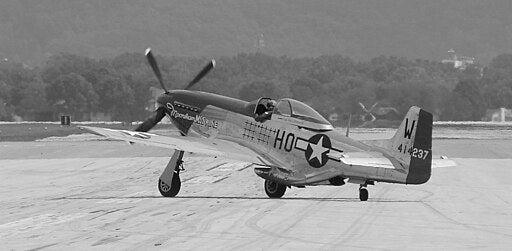When reviewing aviation history, most people can’t help but linger on the P-51 Mustang. This aircraft transcended its World War II glory to carve out a significant niche in the turbulent times of the Cold War. Below, we will unravel the complex narrative of the Mustang, tracing its metamorphosis from a celebrated war hero to a resilient warrior on the Korean battlefield.
World War II: The Pinnacle of Propeller-Driven Performance
Making its grand entrance in the early 1940s, the P-51 Mustang quickly rose to prominence, showcasing itself as the quintessence of propeller-driven mastery. Armed with an impressive combination of extensive range, blistering speed, and nimble agility, it became an indispensable asset in the Allies’ strategic campaign to dominate the aerial realms, particularly across the European skies. The Mustang’s proficiency in accompanying bombers deep into hostile territory shifted the momentum of the aerial conflict, cementing its status as a fearsome opponent high above the battleground.
The Dawn of the Jet Age: Facing the Winds of Change
As the embers of World War II faded, the world was on the brink of a new era, marked by the Cold War’s tension and technological innovation. The advent of jet propulsion threatened to render piston-engine aircraft like the Mustang obsolete. However, the Mustang was not to be quickly consigned to the pages of history.
The Korean Conflict: A Veteran in New Battles
When the Korean War erupted in 1950, the P-51 Mustang, now designated as the F-51, found itself in an unfamiliar landscape, faced with rugged terrain and unpredictable weather conditions. Despite these challenges and the proliferation of faster, jet-powered adversaries, the Mustang demonstrated a remarkable tenacity.
It adapted to its new role, providing critical close air support to ground forces and operating from austere airfields with a reliability that endeared it to pilots. The Mustang showcased exceptional adaptability, proving that even in the face of newer technology, experience and dependability held invaluable worth.
Preserving the Legacy
In the modern era, the P-51 Mustang is a poignant reminder of resilience and adaptability. Museums and airshows across the globe pay homage to this legendary aircraft, ensuring that its story continues to inspire and educate. The Mustang serves as a living connection between two tumultuous periods in history, embodying the transformative journey from the propeller-driven combats of World War II to the high-speed confrontations of the Cold War.
Conclusion
The P-51 Mustang’s odyssey from World War hero to Korean War veteran encapsulates a profound narrative of endurance, innovation, and unwavering dedication. It navigated the sweeping changes of mid-20th-century warfare with grace and tenacity, solidifying its legacy as a timeless icon in the annals of military aviation. Today, the Mustang stands not just as a relic of the past but as a testament to the enduring spirit of innovation and the unquenchable fire of the warrior’s heart.
For more insights into the P-51, F-16, and other important military aircraft, visit Aces In Action. Here, you’ll find an amazing piece of artwork by Craig Tinder titled “American Evolution,” which illustrates the evolution of 30 years between two of America’s front-line air superiority fighters – the P-51 Mustang and the F-16 Fighting Falcon. The limited edition canvas print even includes a piece of specific P-51D-25-NA Mustang fragment from a fuselage panel of aircraft Construction No. 122-40530 (N51TH), making it a unique piece of history!
American Evolution – P-51 & F-16 Aviation Art by Craig Tinder
A tribute to American air power, American Evolution displays two iconic American fighters – the P-51 Mustang and F-16 Fighting Falcon in a display of U.S. air superiority. With just over 30 years of evolution between these aircraft, they served over 25 various countries as front-line fighter aircraft. The P-51 Mustang and F-16 Fighting Falcon can still be seen together at various airshows across the United States.
To purchase or see similar items, visit here.
Commissioned by Museums, Treasured by Collectors





Share:
P-47 Thunderbolt: Dominating the Skies in World War II
Soaring Through History: The Ki-61 Hien and Its Italian Legacy